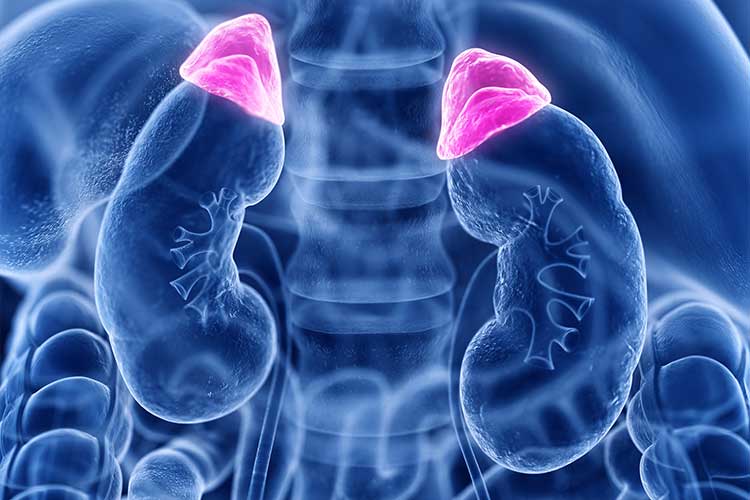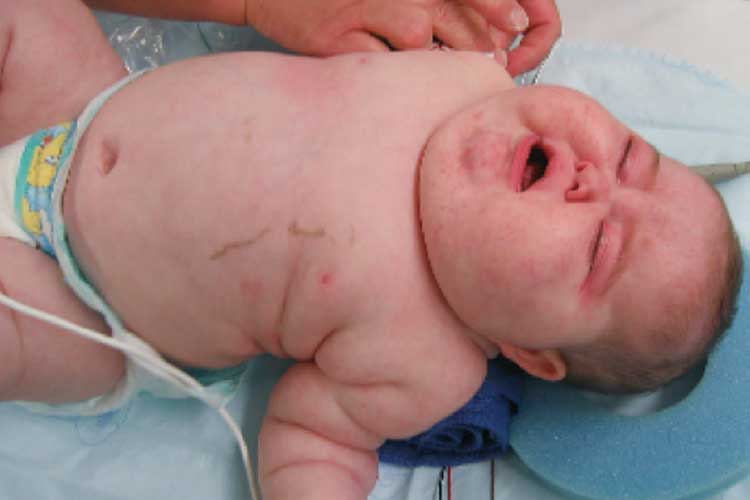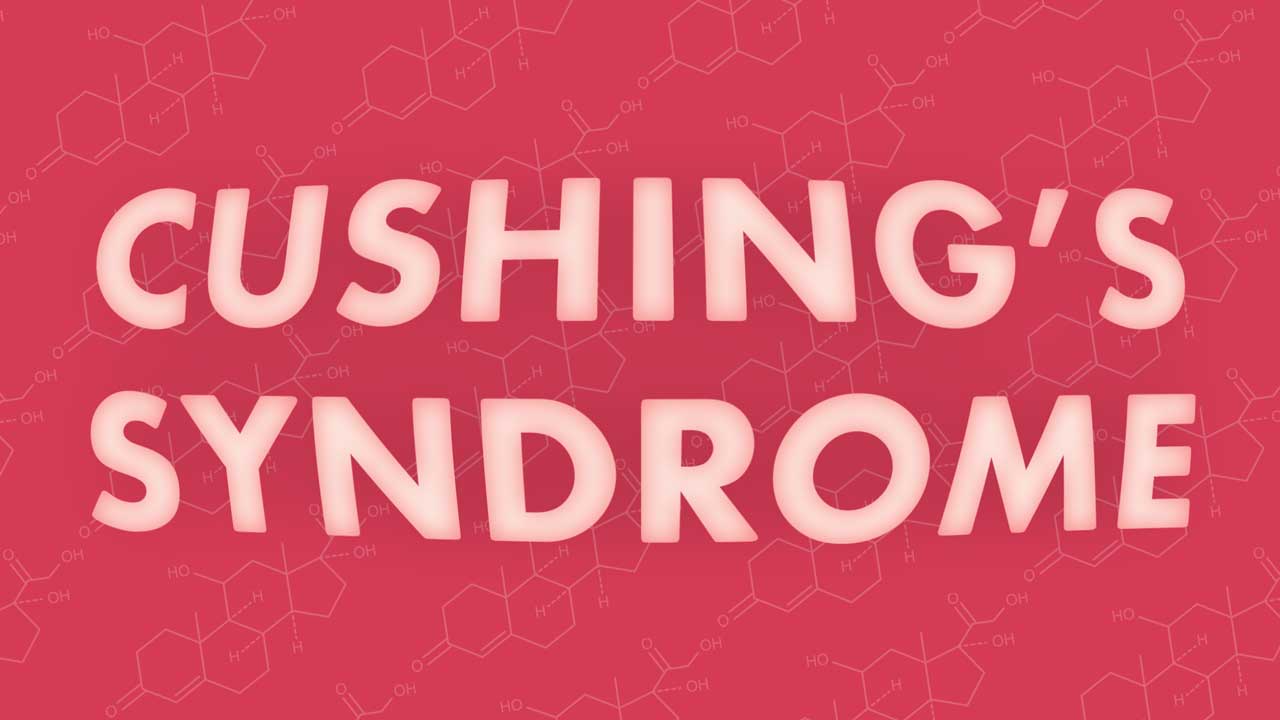Cushing’s syndrome is a rare condition estimated to affect about 1 in 50,000 people and is more common in females than males (Queensland Health 2017).
What is Cushing’s Syndrome?
The term Cushing’s syndrome refers to a group of signs and symptoms caused by the clinical state of hypercortisolism (excess levels of the hormone cortisol) (Uwaifo & Hura 2023).
Cushing’s syndrome directly or indirectly affects most organ systems and can be life-threatening if left untreated (Uwaifo & Hura 2023).
What Causes Cushing’s Syndrome?

The hormone cortisol is produced by the adrenal glands and is released into the bloodstream to facilitate the body’s response to stress or danger. Cortisol is also involved in glucose metabolism and blood pressure regulation and has anti-inflammatory properties (Healthdirect 2022).
Prolonged exposure to high levels of cortisol causes damage to body tissues, leading to the symptoms of Cushing’s syndrome (Mayo Clinic 2023).
A state of hypercortisolism can be caused by either exogenous (external) or endogenous (internal) factors, which include:
- Cushing’s disease, which occurs when a tumour of the pituitary gland produces excessive adrenocorticotropic hormone (ACTH). This, in turn, stimulates the production of excessive cortisol (note that while Cushing’s disease can lead to Cushing’s syndrome, these two conditions are not the same).
- Tumours of the adrenal gland.
- ACTH-producing tumours located outside of the pituitary gland (these are known as ectopic tumours).
- Multiple endocrine neoplasia type 1 (MEN1) - an inherited gene mutation that increases the risk of tumours developing in the endocrine system. Cushing’s syndrome can occur if the pituitary or adrenal gland is affected.
- Glucocorticoid hormone therapy, i.e. the use of glucocorticoid medicines to treat inflammatory conditions, including asthma, rheumatoid arthritis and lupus erythematosus (as glucocorticoids affect the body similarly to cortisol).
(Australian Pituitary Foundation 2023; Yasir et al. 2023; Pathology Tests Explained 2023)
The most common cause of Cushing’s syndrome is a pituitary gland tumour (aka ACTH-dependent Cushing disease), which accounts for almost 70% of cases (Uwaifo & Hura 2023).
Symptoms of Cushing’s Syndrome
The symptoms of Cushing’s syndrome depend on the cause of the hypercortisolism, the levels of cortisol and ACTH in the patient’s body, and the patient’s age and sex (Pathology Tests Explained 2023). They may include:
- Weight gain around the waist, shoulders and neck, but thin arms and legs
- A ‘buffalo hump’ high on the back (caused by an accumulation of fat)
- A rounded, flushed face
- Thin, easily-bruised skin, especially on the legs (as excess cortisol causes an increased breakdown of proteins in the skin)
- Slow healing of wounds
- Muscle weakness (due to breakdown of proteins)
- Fatigue
- Stretch marks on the abdomen, hips and thighs
- Skin pigmentation (especially on scars and inside the mouth)
- Hypertension
- Diabetes
- Osteoporosis
- Mood swings, irritability, anxiety or depression (cortisol directly affects the brain)
- Thirst and frequent urination
- Increased risk of opportunistic bacterial and fungal infections such as pneumonia and tuberculosis
- Irregular menstrual periods
- Increased facial hair in females (ACTH causes the adrenal gland to produce androgens, which promote the growth of facial hair)
- Erectile dysfunction
- Reduced libido.
(Pathology Tests Explained 2023; Healthdirect 2024; Uwaifo & Hura 2023)

If left untreated, Cushing’s syndrome is potentially fatal. This is because hypercortisolism presents a high cardiovascular risk due to its association with hypertension (Uwaifo & Hura 2023).
The most common causes of death in people with Cushing’s syndrome are cardiovascular events, including:
- Acute coronary syndromes
- Thromboembolic events
- Hypertensive complications (including cerebrovascular disease).
(Uwaifo & Hura 2023)
Opportunistic bacterial and fungal infections have also been found to contribute to deaths from Cushing’s syndrome (Uwaifo & Hura 2023).
Diagnosis of Cushing’s Syndrome
Diagnosis may involve:
- A 24-hour urine test to detect cortisol levels in the urine
- An overnight dexamethasone test to assess the body’s reaction to glucocorticoids
- Blood and/or salivary cortisol measurements at 9 am and midnight (cortisol is typically high in the morning and decreases throughout the day, but someone with Cushing’s syndrome will still have high cortisol levels at midnight)
- Blood tests to measure ACTH levels at 9 am (a low level of ACTH indicates that symptoms are being caused by an adrenal tumour or glucocorticoid medicines)
- An extended dexamethasone test to determine whether excess ACTH is being caused by a pituitary tumour or ectopic tumour
- A CT scan or MRI scan to examine the pituitary and adrenal glands for tumours
- An octreotide scan, in which octreotide labelled with a radioactive tag is injected into the body, allowing the detection of hormone-producing tumours via radiologic scan.
(Pathology Tests Explained 2023)
Treatment for Cushing’s Syndrome
The main goal of treatment is to eliminate the underlying cause of excess cortisol production (Pathology Tests Explained 2023).
Treatment options for pituitary gland, adrenal gland or ACTH-producing ectopic tumours include:
- Surgical removal (which may need to be followed by chemotherapy, immunotherapy, radiation therapy or hormone replacement therapy)
- Radiation therapy to shrink the tumour and prevent it from producing cortisol (if surgery is contraindicated or unsuccessful)
- Medicine to regulate cortisol levels
- Bilateral adrenalectomy (removal of the adrenal glands) - this is typically only performed if surgery and radiation therapy are contraindicated.
(Australian Pituitary Foundation 2023)
If glucocorticoid medicines are causing Cushing’s syndrome, the patient’s dose may be gradually reduced. However, this may not completely resolve symptoms. Note that glucocorticoids should never be stopped abruptly (Pathology Tests Explained 2023).
Test Your Knowledge
Question 1 of 3
Which one of the following is NOT a symptom of Cushing’s syndrome?
Topics
Further your knowledge
References
- Australian Pituitary Foundation 2023, A Guide to Cushing’s Disease, Australian Pituitary Foundation, viewed 19 February 2025, https://pituitary.asn.au/wp-content/uploads/2023/09/APF-Cushings-Fact-Sheet-2023_Digital.pdf
- Healthdirect 2022, The Role of Cortisol in the Body, Australian Government, viewed 19 February 2025, https://www.healthdirect.gov.au/the-role-of-cortisol-in-the-body
- Healthdirect 2024, Cushing's Syndrome, Australian Government, viewed 20 February 2025, https://www.healthdirect.gov.au/cushings-syndrome
- Mayo Clinic 2023, Cushing Syndrome, Mayo Clinic, viewed 19 February 2025, https://www.mayoclinic.org/diseases-conditions/cushing-syndrome/symptoms-causes/syc-20351310
- Pathology Tests Explained 2023, Cushing’s Syndrome, Pathology Tests Explained, viewed 19 February 2025, https://pathologytestsexplained.org.au/ptests-pro.php?q=Cushing%27s+Syndrome
- Queensland Health 2017, Cushing's Syndrome, Queensland Government, viewed 19 February 2025, https://www.qld.gov.au/health/condition/nutritional-diet-and-hormonal-health/pituitary-gland-problems/cushings-syndrome
- Uwaifo, GI & Hura, DE 2023, ‘Hypercortisolism’, StatPearls, viewed 19 February 2025, https://www.ncbi.nlm.nih.gov/books/NBK551526/
- Yasir, M, Goyal, A & Sonthalia, S 2023, ‘Corticosteroid Adverse Effects’, StatPearls, viewed 20 February 2025, https://www.ncbi.nlm.nih.gov/books/NBK531462/
 New
New 

